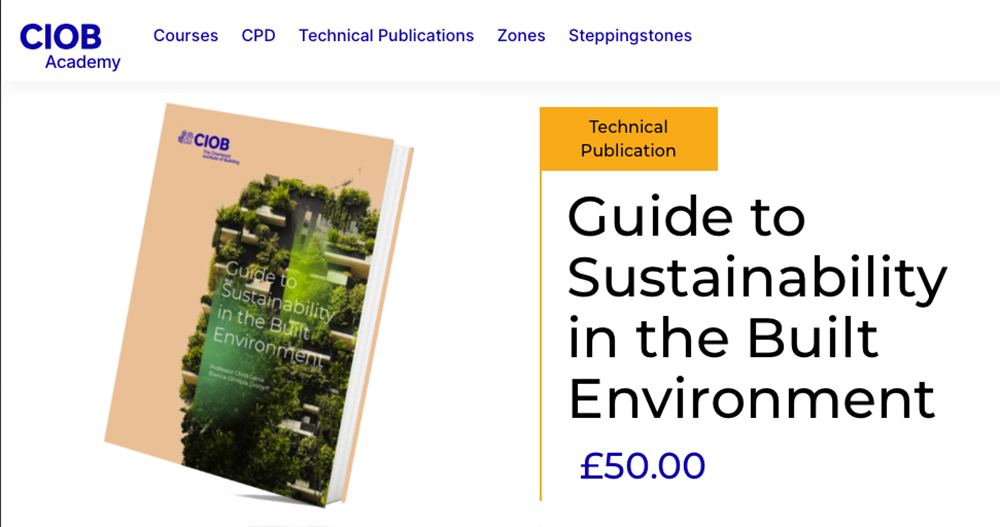Guide to sustainability in the built environment
Contents |
[edit] The Chartered Institute of Building (CIOB) has launched a new sustainability guide for built environment professionals.
The guide covers topics including sustainability development goals, green financing, embodied and operational carbon, biodiversity and social value. It offers practical tools and strategies to help readers embrace sustainable practices during the planning, construction and ongoing operation of a building to support national and global efforts to reach net zero, while also improving the environment for surrounding communities.
Dr Gina Al-Talal, FCIOB, head of technical technical and standards development at CIOB, said: “Sustainability guides are now fairly common but ours is specifically tailored to the construction profession so will be an extremely valuable resource for our members and the wider sector. It provides a reference point at every stage of a construction project and emphasises the importance of integrating sustainable practices and the difference this can make to the environment and local communities.”
Amanda Williams, Head of Environmental Sustainability at CIOB, said: “The construction industry has a vital role to play in responding to the twin challenge of climate change and biodiversity loss. We must harness all the skill and ingenuity of the sector, as we aim to ensure that the projects we deliver today make a positive contribution to the kind of future we want to see. This comprehensive guide to sustainability in the built environment is essential reading for construction professionals as they work to make their difference to this defining challenge and put sustainability at the heart of everything they do.”
Dr Michael Yam, FCIOB, CIOB’s 2022/23 President, said: “The construction and built environment sector needs to reset as the 2050 net zero target approaches. This means a movement towards more intensive use of modern methods of construction, more off-site work, more innovative use of materials, more infrastructure directly supporting zero-carbon energy production, and more re-fitting than knocking buildings down. At the CIOB, our goal is to help steer the sector through turbulent waters, keeping an eye on our destination of a safe, carbon neutral, high-quality built environment. A built environment that contributes to the achievement of the Sustainable Development Goals. It is our hope that this sustainability guide will serve as a roadmap to get us to that destination.”
The new publication - ‘A guide to Sustainability in the Built Environment’, is available on the CIOB’s website https://ciob.me/sustainabilityGuide priced at £50 (£40 for CIOB members).
[edit] Guide to Sustainability in the Built Environment published by CIOB
This Guide to Sustainability in the Built Environment provides a comprehensive reference for stakeholders in the buildings and construction sector, introducing sustainability principles, offering tools for addressing climate, nature, and social challenges at organisational and project levels, and outlines the benefits of adhering to relevant standards and environmental certifications. Only available electronically. CIOB members receive 20% discount.
[edit] Summary
Although sustainability is steadily growing in importance for businesses, governments and other societal actors, it remains a developing agenda with change closely following recognised science. This guide offers practices based on best available knowledge at this time and should act as a reference point for professions associated with the buildings and construction sector, including clients, contractors, construction managers, designers, facility managers, building owners, tenant groups and others looking for integrated pathways to sustainability.
[edit] Contents
- The challenge ahead of us
- Sustainability and the Sustainability Development Goals
- The Global Transition to Sustainability
- Corporate Sustainability
- Managing Risk
- Sustainable and Green Finance
- Sustainable and Operational Assessment
- Sustainability Standards: Introduction and Global Review
- Sustainability Standards and Asset Value
- Life Cycle Analysis of Embodied and Operational Carbon and Energy
- Biodiversity Conservation and Construction
- Social Sustainability and Social Value
[edit] About the Author
Chris Gorse (MICOB) is Professor of Construction Engineering and Management at the University of Loughborough and Chair of the CIOB Sustainability Panel and Policy Forum. Leading major research projects for government and industry, with a focus on the built environment, quality and energy efficiency.
Bianca Drotleff (GradIEMA) is a project manager and works with organisations who look at new sustainability approaches and tools, circular economy, zero carbon and resilient business models
This article was published on the CIOB news and blog site as "Guide to Sustainability in the Built Environment", dated October 4, 2023 and appears on the CIOB Academy site under the same name.
--CIOB
[edit] Related articles on Designing Buildings
- Biotechnology: The key to zero energy buildings.
- Circular Construction in Regenerative Cities (CIRCuIT).
- Circular economy.
- Climate change science.
- CRC Energy Efficiency Scheme.
- Earth overshoot day.
- Ecological impact assessment.
- Economic sustainability.
- Emission rates.
- Energy Act.
- Energy Performance Certificates.
- Energy Related Products Regulations.
- Energy targets.
- Environmental impact assessment.
- Environmental legislation.
- Environmental plan.
- Global Real Estate Sustainability Benchmark GRESB.
- Green building.
- Intergovernmental Panel on Climate Change.
- Low carbon.
- Mean lean green.
- Passivhaus.
- Reduce, reuse, recycle.
- Regenerative design.
- Scotland publishes plans to reach net zero targets with Heat in Buildings Strategy.
- Site waste management plan.
- The sustainability of construction works
- Sustainable development.
- Sustainable materials.
- Sustainable procurement.
- Sustainable urban drainage systems.
- Sustainability appraisal.
- Sustainability aspirations.
- Sustainability in building design and construction.
- Sustainability in facility management.
- The Carbon Plan: Delivering our low carbon future.
- Upcycling.
- UK Climate Change Risk Assessment.
- Zero carbon homes.
- Zero carbon non-domestic buildings.
Featured articles and news
One of the most impressive Victorian architects. Book review.
RTPI leader to become new CIOB Chief Executive Officer
Dr Victoria Hills MRTPI, FICE to take over after Caroline Gumble’s departure.
Social and affordable housing, a long term plan for delivery
The “Delivering a Decade of Renewal for Social and Affordable Housing” strategy sets out future path.
A change to adoptive architecture
Effects of global weather warming on architectural detailing, material choice and human interaction.
The proposed publicly owned and backed subsidiary of Homes England, to facilitate new homes.
How big is the problem and what can we do to mitigate the effects?
Overheating guidance and tools for building designers
A number of cool guides to help with the heat.
The UK's Modern Industrial Strategy: A 10 year plan
Previous consultation criticism, current key elements and general support with some persisting reservations.
Building Safety Regulator reforms
New roles, new staff and a new fast track service pave the way for a single construction regulator.
Architectural Technologist CPDs and Communications
CIAT CPD… and how you can do it!
Cooling centres and cool spaces
Managing extreme heat in cities by directing the public to places for heat stress relief and water sources.
Winter gardens: A brief history and warm variations
Extending the season with glass in different forms and terms.
Restoring Great Yarmouth's Winter Gardens
Transforming one of the least sustainable constructions imaginable.
Construction Skills Mission Board launch sector drive
Newly formed government and industry collaboration set strategy for recruiting an additional 100,000 construction workers a year.
New Architects Code comes into effect in September 2025
ARB Architects Code of Conduct and Practice available with ongoing consultation regarding guidance.
Welsh Skills Body (Medr) launches ambitious plan
The new skills body brings together funding and regulation of tertiary education and research for the devolved nation.
Paul Gandy FCIOB announced as next CIOB President
Former Tilbury Douglas CEO takes helm.


























